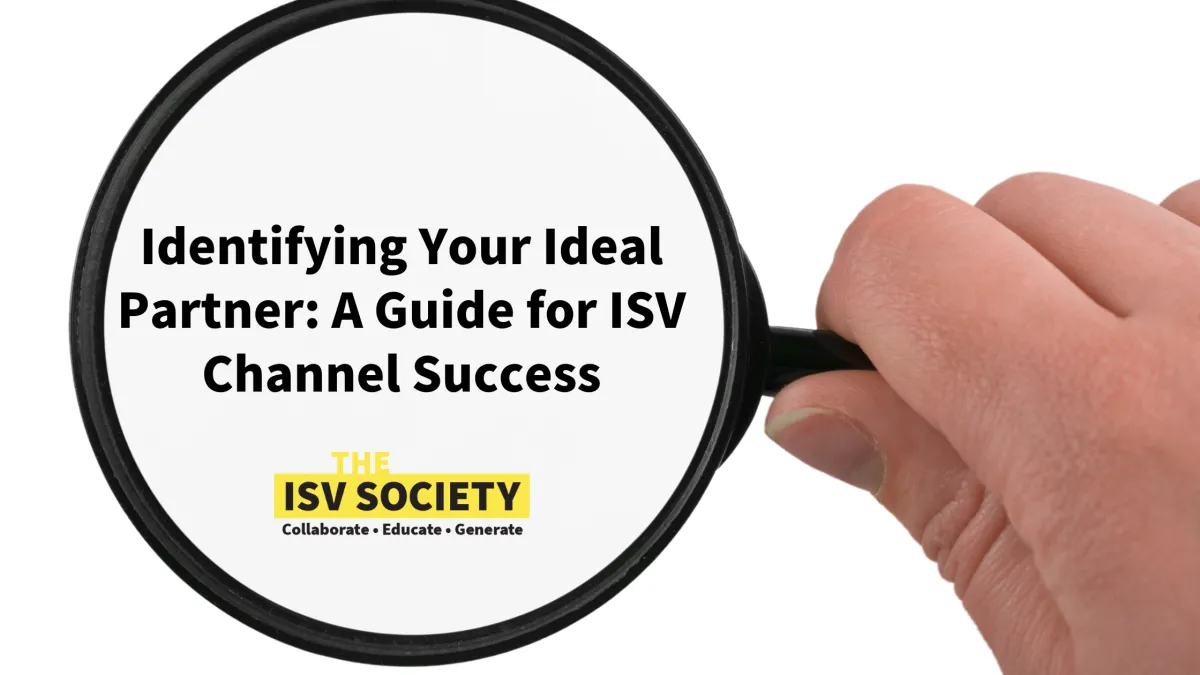
Blog Fest
Get the latest trends, tips-n-tricks, event updates, and more.

Identifying Your Ideal Partner: A Guide for ISV Channel Success
Introduction:
ISVs face a constant challenge: reaching the right audience and maximizing their product's impact. Here's where a strong channel partner program comes in. You can significantly accelerate your growth by partnering with established VARs with the reach and expertise to promote your solution effectively. But not just any partner will do. Finding the ideal partner is like finding your perfect business match – someone who shares your vision and drives mutual success.
This blog shares some key characteristics of an ideal channel partner, helping you identify the perfect fit to grow your partner channel.
Understanding the Channel Landscape
Before executing your partner plan, it’s crucial to understand the ISV channel landscape. The ecosystem is diverse, with partners ranging from large enterprises to niche specialists. Each potential partner brings a unique set of strengths, market focuses, and customer bases.
Understanding Your Value Proposition
It's crucial to have a clear understanding of your own value proposition. What unique problem does your software solve? Who is your target customer? Answering these questions will help you identify partners who can effectively resonate with your ideal customer base and understand the specific value your solution brings.
Seeking Alignment: Core Values and Target Market
Your ideal partner should share your core values and vision. Look for partners with a strong reputation for customer service, integrity, and a commitment to innovation. These shared values will foster a strong foundation for a collaborative and successful partnership.
Furthermore, target market alignment is essential. Does your partner have a strong presence in the industry you're targeting? Do they possess established relationships with the type of customers who would benefit most from your product? Partnering with companies that already cater to your ideal customer profile significantly increases the chances of successful lead generation and sales conversion.
Defining Your Ideal Partner Profile
Identifying your ideal partner is to define what ‘ideal’ looks like for your business. Consider the following aspects:
Market Alignment: Does the partner’s customer base align with your target market?
Cultural Fit: Do their values and business practices resonate with yours?
Technical Synergy: Is there a technological complementarity between your offerings?
Sales and Marketing Strength: Can they effectively sell and market your product?
Complementary Skillsets and Expertise
A successful partnership thrives on a synergy of strengths. While your expertise lies in developing innovative software solutions, your ideal partner will excel in areas like marketing, sales, and customer support. Look for partners with a proven track record in these areas who can complement your offerings and take your product to market with maximum impact.
Here are some specific skills to consider:
Marketing: Can they effectively leverage their existing channels (website, social media, events) to promote your solution?
Sales: Evaluate your partner's sales team's capabilities. Do they have the experience and training necessary to sell your product? Are they familiar with your target market and its specific needs?
Customer Support: Does your partner have a customer support team? Are their support personnel equipped to handle inquiries and know who to work with on your team to help with any client-facing issues?
Building Trust and Transparency
A strong partnership thrives on open communication and mutual trust. Choose a partner with a proven track record of successful collaboration. Look for partners who are willing to share data, insights, and feedback to ensure continuous improvement and a win-win scenario for both parties.
Building a Relationship
Once you have that partner, that’s when the work really starts. The main objective is to focus on building that relationship. This involves:
Communication: Establish clear and open channels of communication.
Joint Planning: Work together to create a joint business plan that outlines goals, roles, and expectations.
Enablement: Invest in training and enablement to ensure their team understands your product.
Investing in the Partnership
Building a successful partnership requires a commitment from both sides. Look for partners who are willing to invest their resources in training their teams on your product, developing co-marketing campaigns, and participating in joint sales initiatives. This mutual investment demonstrates a genuine dedication to maximizing the partnership's potential.
Scalability and Long-Term Vision
While short-term gains are important, consider the long-term trajectory of the partnership. Does your partner share your vision for future growth? Are they equipped to scale their operations alongside your product's success? Choosing a partner with a growth-oriented mindset ensures a sustainable and mutually beneficial relationship.
For a partnership to thrive in the long term, it must be nurtured. This means:
Continual Learning: Stay abreast of each other’s product developments and market strategies.
Adaptability: Be willing to adapt the partnership as your businesses evolve.
Recognition and Rewards: Celebrate successes and recognize contributions to foster a positive partnership dynamic.
Finding Your Ideal Partner: Beyond the Checklist
While the characteristics listed above provide a strong foundation for identifying ideal partners, don't underestimate the importance of a good fit on a personal level. Building strong working relationships with your partner's team fosters smoother communication, fosters collaboration, and ultimately, a more successful partnership.
Measuring Success
To ensure the partnership is fruitful, set up metrics for success as well as a regular cadence of meetings and updates. These could include sales targets, joint marketing initiatives, and marketing campaign metrics. Regularly review these numbers and adjust your strategy as needed.
Taking the Next Step
Now that you have a clearer picture of your ideal partner profile, the next step is to proactively initiate your search. Leverage industry events, online partner directories, and recommendations from trusted associates to connect with potential partners. Take your time, conduct thorough due diligence, and engage in open conversations to ensure a perfect fit. Remember, a successful partnership is built on mutual respect, shared values, and a commitment to achieving common goals.
© Copyright 2022 The ISV Society
